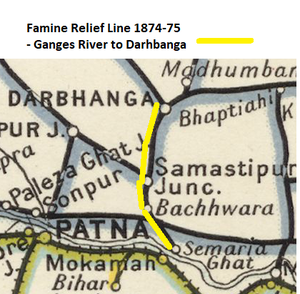Famine Relief Line 1874-75 - Ganges River to Darhbanga
Famine Relief Line 1874-75 - Ganges River to Darhbanga

A famine relief line from the Ganges River to Durbhunga (modern name Darhbanga) was constructed in 1874-75, a distance of 53 miles(85km). Soon after opening it was named the ‘Tirhut State Railway’ and later as the ‘Tirhoot State Railway’ - see separate page.
The ‘Annual Report for Railways 1874-75’ [1] stated:-.
“ The construction of the temporary line from the Ganges to Durbhunga, fifty-three miles of length, opened after only fifty-three days, was an extraordinary achievement in respect of spee. To carry the line over a country intersected by three considerable streams; to make it strong enough to carry 2,000 tons in a day; to open it within the prescribed time, demanded an indefatigable energy, but also professional skill and administrative ability. All these qualities were displayed by Major F.S.Staton,R.E., the Engineer-in-Chief” assisted by Lieut W.H.Rathbone, R.E..”
”Major Lindsay was Engineer-in-chief of the ‘Bengal and North-Western Railway '’ (B&NWR) , the commencement of which was undertaken as relief work. The railway was designed before the famine”
The ‘1908 Railway Map’ [2] shows the route from Semaria Ghat on the Ganges via Bachhwara and Samastipur to Darhbanga. The line opened on 1 Nov 1875 and became the first part of the ‘Tirhoot State Railway’ [3], which was worked as part of the ‘Bengal and North-Western Railway’ (B&NWR) network.
References
- ↑ ‘Annual Administration Reports for Railways 1874-75’, para 18, page 9; Retrieved 13 Apr 2020
- ↑ ‘Imperial Gazetteer of India, v. 26, Atlas 1909 edition, Railway Map--Sectional (2)’, p. 24.; Retrieved 13 Apr 2020
- ↑ “Administration Report on Railways 1918” page 164 (pdf172); Retrieved 13 Apr 2020